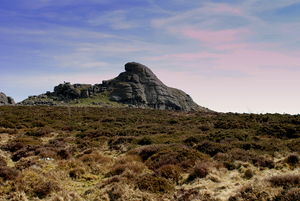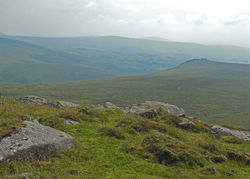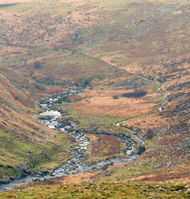Dartmoor: Difference between revisions
imported>Martin Wyatt |
imported>Martin Wyatt |
||
| Line 11: | Line 11: | ||
== Geology == | == Geology == | ||
The underlying rock of Dartmoor is a [[granite]] massif which has risen through the older sedimentary rocks around it. The mineral veins formed during this process include [[tin]], [[copper]], [[lead]] and [[iron]]. | The underlying rock of Dartmoor is a [[granite]] massif which has risen through the older sedimentary rocks around it. The mineral veins formed during this process include [[tin]], [[copper]], [[lead]] and [[iron]]. Granite can decompose into china clay, and this is extracted on the south-western slopes. In the same area a former wolfram ([[tungsten]]) mine is at the moment (2015) being reopened. | ||
== Archaeology == | == Archaeology == | ||
Revision as of 09:08, 26 April 2015
Dartmoor is an area of moorland in the county of Devon in south-west England, characterised by gentle slopes, granite tors and high rainfall creating much boggy ground. It is designated as a National Park. The highest points are High Willhays (621m or 2039 ft) and Yes Tor (619m or 2030 ft) near to each other on the north-west edge.[1]
The area covered by the National Park is 954 sq km (368 sq miles). Within this are several villages or small towns, the total population being estimated at around 34,000. The National Park Authority itself is responsible for planning, conservation, promotion of public access and some other functions. Other local authority services are provided by Devon County Council or the three district authorities which cover the area. The ownership of the land is varied. The Ministry of Defence carries out military training on 12,906 hectares (31,891 acres), of which 10,871 hectares (26,862 acres), known as the Defence Training Estate, is owned or leased by it. Just under half of the National Park is estimated to be moorland, the remainder being mostly farmland.[2]
Dartmoor is known for its ponies which roam freely on the moor. The ponies are semi-wild, but all have owners. Archaeological findings have shown that there were domesticated ponies about 3,500 years ago, and the earliest written record (a reference to wild horses owned by the Bishop of Crediton) dates from 1012. The numbers have reduced in recent years to about 3,000.[3]
Geology
The underlying rock of Dartmoor is a granite massif which has risen through the older sedimentary rocks around it. The mineral veins formed during this process include tin, copper, lead and iron. Granite can decompose into china clay, and this is extracted on the south-western slopes. In the same area a former wolfram (tungsten) mine is at the moment (2015) being reopened.
Archaeology
The moor has been intensively used since at least the Bronze Age, without being intensively settled. This has resulted in the survival of many sites of archaeological interest.
The acid soil has destroyed much of the evidence in sites of human habitation and interment, and the recent (2011) discovery of a Bronze Age burial kist on Whitehorse Hill is not only rare in revealing organic material from that era, but unique to Dartmoor. The burial was of the remains from a human cremation, probably of a high status young woman. It has been dated to the Early Bronze Age, between 1900 and 1700 BC, and it has yielded much information about conditions at that time. The terrain seems to have shifted from being predominantly damp, to consisting, below the tops, of drier areas with moor grass and heathers, and, lower down, thin woodland. There is evidence of grazing. The kist contained fine quality woven goods, tin and copper alloy products, and turned wooden studs, unique at this period. The well-worn amber bead suggests trade with the Baltic that was already long-standing.[4]
There are significant remains of settlements, burial sites, stone rows, old boundaries, farming, warrening, tinning, mining for tin and other metals, peat extraction, quarrying, water extraction, and other activities.[5] There are many leats (artificial watercourses), constructed to bring water or water power to where it was needed, and a lot of these are still in use.
The moor in literature
The Sherlock Holmes story, The Hound of the Baskervilles was set on Dartmoor. Conan Doyle, who had been a GP in nearby Plymouth, stayed at a hotel in Princetown at the centre of the Moor, and was said to have had Foxtor Mire in mind when writing of the Great Grimpen Mire.
Dartmoor Prison
Dartmoor Prison started as part of Sir Thomas Tyrwhitt's project to develop Dartmoor. He committed himself to developing Princetown as a centre for the moor, it being adjacent to his new house at Tor Royal, and named in honour of the Prince Regent, a friend of his. In 1805 he persuaded the government of the desirability of using Princetown for building barracks for French prisoners of war, many of whom had been confined in hulks on the nearby river Tamar. Building started in 1806, to a radial design based on continental models and later advocated by Jeremy Bentham as the Panopticon,[6] except that the spokes of the wheel were supervised from the perimeter wall rather than from the central point.[7] In 1809 the first prisoners of war arrived, and the "depot", as it was first called, soon held 5,000 of them. None of them were actually engaged in building the prison, but some were employed in building the nearby church of St Michael and All Angels. During the war of 1812 American prisoners of war were also held there. Following the restoration of peace, the prison closed in 1816 and stood mainly empty until 1850, when it became a prison for those serving long-term sentences. The first of these did work on adapting the buildings to single cells. During the 1914-18 war it also housed conscientious objectors.
- ↑ [1]
- ↑ [2]
- ↑ [3]
- ↑ Dartmoor National Park Authority. Whitehorse Hill information booklet 2014 (associated with exhibition in Plymouth City Museum, 2014)
- ↑ Newman, P. The Field Archaeology of Dartmoor. English Heritage. 2011
- ↑ Foucault, M. Surveiller et punir: Naissance de la prison. English translation by Alan Sheridan. Allen Lane. 1977
- ↑ Cherry, C and Pevsner, N. The Buildings of England: Devon. Yale University Press. 2004


